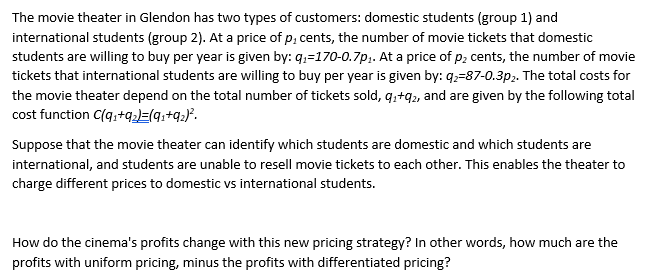Suppose that the movie theater can identify which students are domestic and which students are international, and students are unable to resell movie tickets to each other. This enables the theater to charge different prices to domestic vs international students. How do the cinema's profits change with this new pricing strategy? In other words, how much are the profits with uniform pricing, minus the profits with differentiated pricing?
Suppose that the movie theater can identify which students are domestic and which students are international, and students are unable to resell movie tickets to each other. This enables the theater to charge different prices to domestic vs international students. How do the cinema's profits change with this new pricing strategy? In other words, how much are the profits with uniform pricing, minus the profits with differentiated pricing?
Chapter1: Making Economics Decisions
Section: Chapter Questions
Problem 1QTC
Related questions
Question

Transcribed Image Text:The movie theater in Glendon has two types of customers: domestic students (group 1) and
international students (group 2). At a price of p, cents, the number of movie tickets that domestic
students are willing to buy per year is given by: q₁-170-0.7p₁. At a price of p₂ cents, the number of movie
tickets that international students are willing to buy per year is given by: q₂-87-0.3p2. The total costs for
the movie theater depend on the total number of tickets sold, 9₁+92, and are given by the following total
cost function C(q₁+q₂)=(9₁ +9₂) ².
Suppose that the movie theater can identify which students are domestic and which students are
international, and students are unable to resell movie tickets to each other. This enables the theater to
charge different prices to domestic vs international students.
How do the cinema's profits change with this new pricing strategy? In other words, how much are the
profits with uniform pricing, minus the profits with differentiated pricing?
Expert Solution
This question has been solved!
Explore an expertly crafted, step-by-step solution for a thorough understanding of key concepts.
Step by step
Solved in 2 steps

Knowledge Booster
Learn more about
Need a deep-dive on the concept behind this application? Look no further. Learn more about this topic, economics and related others by exploring similar questions and additional content below.Recommended textbooks for you


Principles of Economics (12th Edition)
Economics
ISBN:
9780134078779
Author:
Karl E. Case, Ray C. Fair, Sharon E. Oster
Publisher:
PEARSON

Engineering Economy (17th Edition)
Economics
ISBN:
9780134870069
Author:
William G. Sullivan, Elin M. Wicks, C. Patrick Koelling
Publisher:
PEARSON


Principles of Economics (12th Edition)
Economics
ISBN:
9780134078779
Author:
Karl E. Case, Ray C. Fair, Sharon E. Oster
Publisher:
PEARSON

Engineering Economy (17th Edition)
Economics
ISBN:
9780134870069
Author:
William G. Sullivan, Elin M. Wicks, C. Patrick Koelling
Publisher:
PEARSON

Principles of Economics (MindTap Course List)
Economics
ISBN:
9781305585126
Author:
N. Gregory Mankiw
Publisher:
Cengage Learning

Managerial Economics: A Problem Solving Approach
Economics
ISBN:
9781337106665
Author:
Luke M. Froeb, Brian T. McCann, Michael R. Ward, Mike Shor
Publisher:
Cengage Learning

Managerial Economics & Business Strategy (Mcgraw-…
Economics
ISBN:
9781259290619
Author:
Michael Baye, Jeff Prince
Publisher:
McGraw-Hill Education